Owner attributes to Moll Sr. and I can't argue given only these photos. I'm going to ask for a better series and I'll include the owner's remarks to me.
"Attached are three pictures of a long rifle that I acquired years ago from a dealer. I am hoping to get an idea of possibly the gunmaker, date or period it was made, maybe a value but that isn't quite so important. I will write a 'new topic' concerning this rifle in the pre1899 firearms forum. Thought I would send you the pictures first and be sure they are ok for posting. If the are acceptable, let me know and I will go ahead with the write up. I have the files labeled as 'Moll rifle' because the dealer I purchased this from attributed this to John Moll Sr. Hope to find out definitely though. Thanks for your help."
Addendum:
Here's a bit more info on the rifle. Overall length of 61in. Smoothbore barrel of 0.69 cal and 45 1/2 inch length. Octagon at breech to round with applied brass strips the length of the barrel. Barrel may be a recycled barrel of European origin as there is a faint mark on the top facet of the breech that may be a proof mark of some kind but is not clear. Lock appears to my eye to be original to the gun. Brass furniture including triggerguard, ramrod pipes, sideplate, and patchbox. Patchbox certainly looks to be in line with John Moll's work at least from pouring over the references I have but I am certainly not an expert. There is no signature on the barrel, lock or sideplate. Right side of wrist has "3C" carved. The dealer I purchased this from stated that he believed the rifle may have been Moll's personal weapon as Moll apparently was a member of the 3rd company, 1st battalion Northhampton Militia in 1777. Documents supporting this claim were to have been sent to me but never materilaized, unfortunately.
Some may term this rifle a buck and ball rifle. Others may term this a thin-walled smoothbore or perhaps a fowler. Any help in providing information on this rifle would be much appreciated.
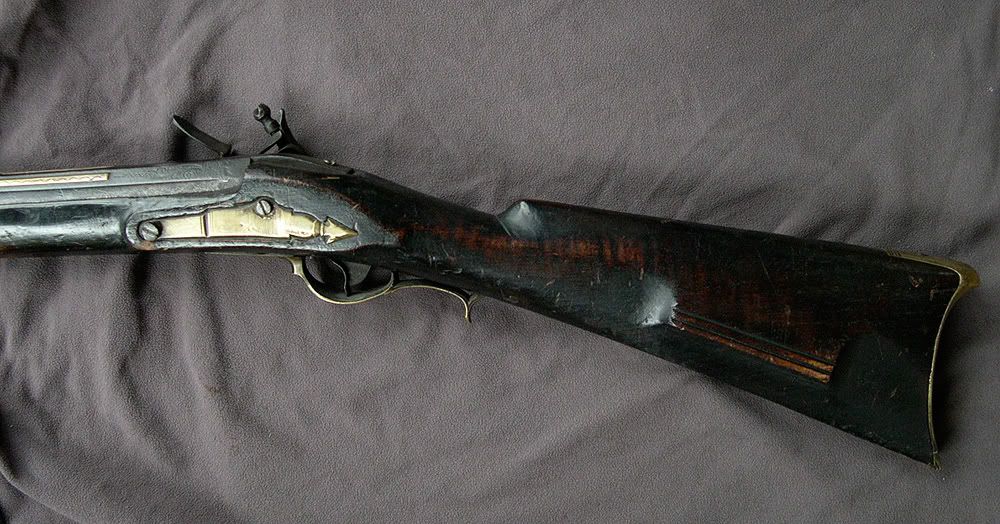



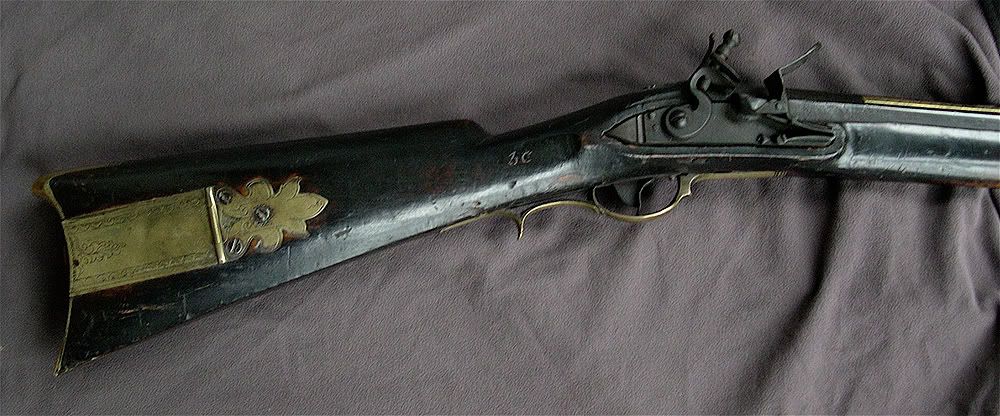



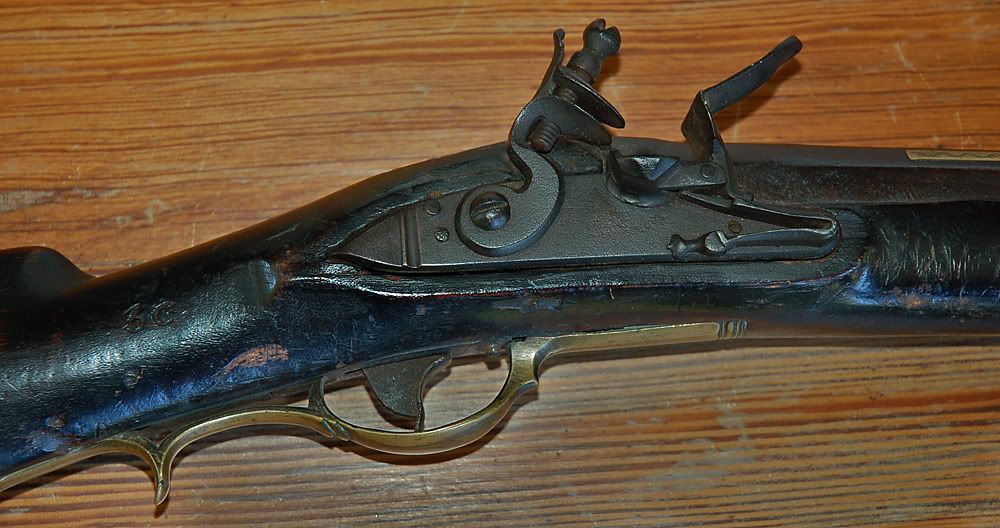
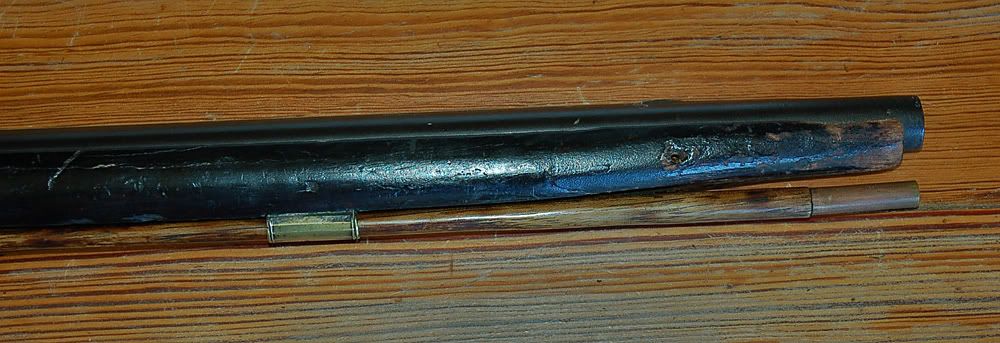
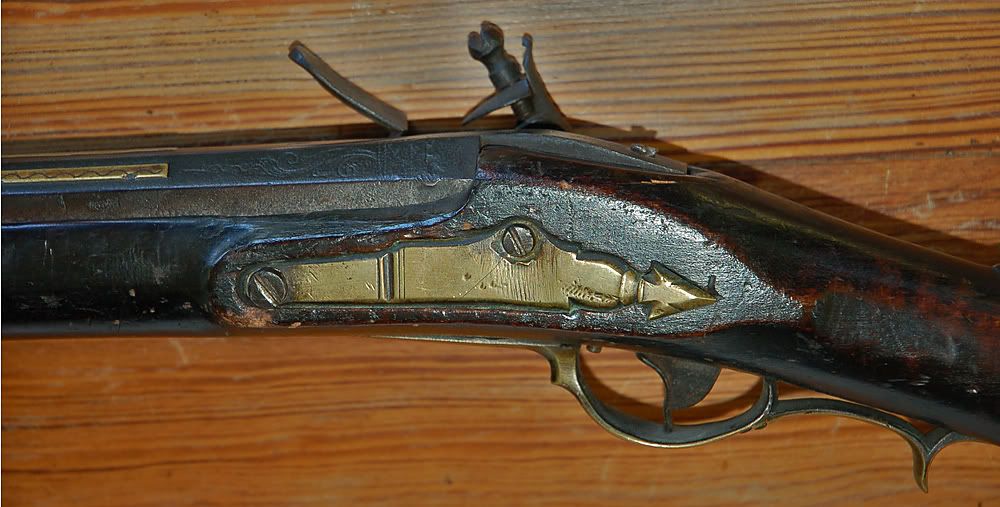
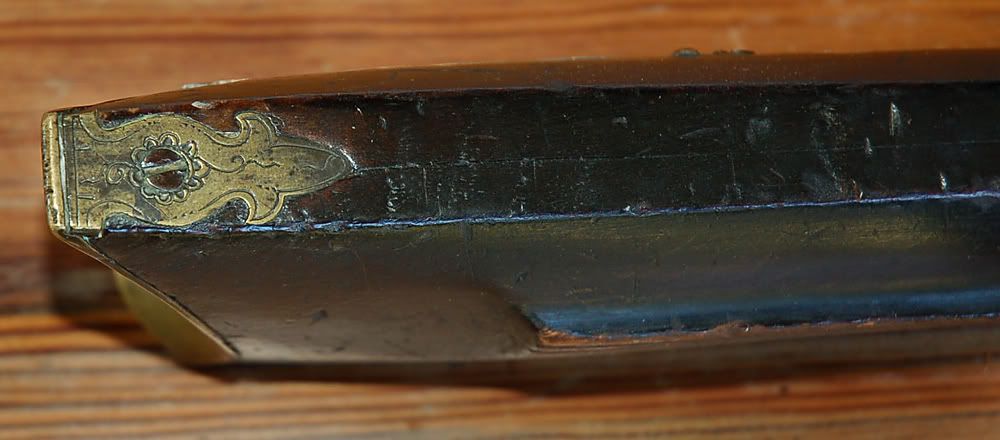









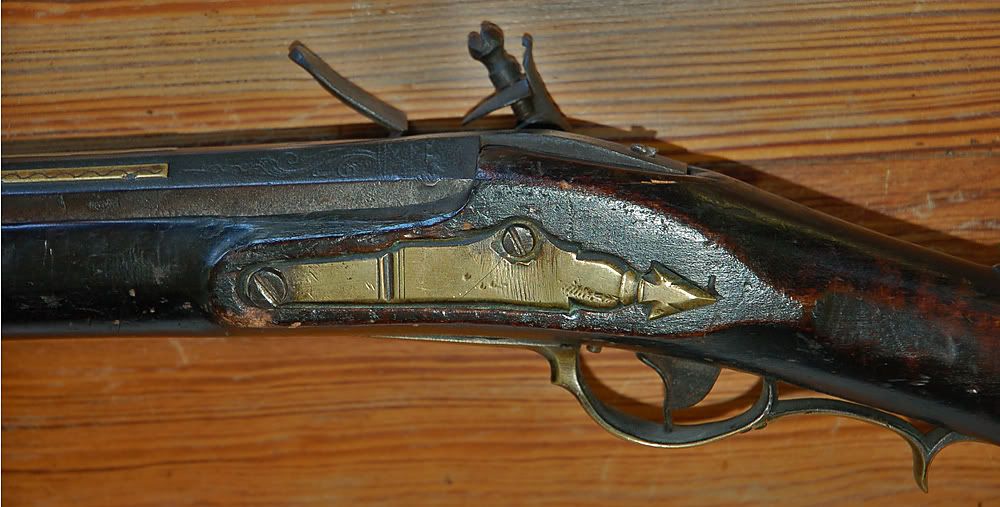

Comments:
Looks like some Moll parts on a later restock with Spanish barrel. Stocking quality doesn't match the quality of mounts, in my opinion.
-----------------------------------------------------------------------------------------------
I have to agree with XXXX. The only things that look like Moll's work to me might be the patch box, the side plate and the toe plate, although I can't be sure of even those. If any of the hardware is actually by Molls hand it has been used in a restock. The stock architecture is all wrong and doesn't appear to be Moll's work. The trigger guard is wrong and the trigger looks like it came off a military musket. Nope, not a product of Moll in my opinion.
------------------------------------------------------------------------------------------------
Comments from Antiqueguns... Jim Whisker
1. "Moll rifles, Allentown area generally, rifles were archaic, made w/ wider butts, etc, earlier features long after went out of style elsewhere. Of all schools this is 1 most likely to be dated too early. Of course I would like to see the PB side. This seems not as wide as J Moll Sr guns I have photographed. I'd put it down a generation. opinion of course."
2. "A few more comments. With a smooth bore it is likely a smooth rifle, name given, literal translation from German, made like a rifle but w/o rifling, term often used to distinguish it from a buck & ball or fowling piece. Trigger guard seems less wide than most Moll rifles I have seen. Why no rifling? in large bore it could more easily be used w/ shot, large or small size or combination of ball + shot. @!*% nice piece, my heartiest congratulations."
Note:
Dr. Whisker's first comment was made on the basis of only the three original photos. Second was after the full series.
My personal feelings remain pretty much unchanged. I certainly can't endorse direct attribution to Moll and the barrel treatment surely recalls a somewhat Spanish influence. Trigger is heavy and archaic. Then again, this tends to agree with Whisker when he stated that Moll rifles often recalled a much earlier time. The stock bothers me less than some others of you. I could see a valid argument either way.
I would conclude (from a historical standpoint) that this is a fine example of a period rifle. As such it belongs in the library. I would further conclude from a detail standpoint that too many questions remain to tie the rifle to Moll absent a signed piece of similar construction or some provenance.
One more point... Should the rifle hail from the Revolution, then we should probably consider that a man such as Moll might well have needed a rifle in short order. He had the ability to use available components and may well have chosen the most expedient route to this end. The stock and somewhat heavy-handed components such as the trigger wouldn't be out of character if a piece were being made for something other than hunting.
I vote for inclusion to the library and against a direct association with Moll, though I'd not exclude the possibility.
------------------------------------------------------------------------------------------------
The toe plate appears to tie the hardware to the Moll family of gunmakers. Even the trigger guard is in the Molll style with heavy front post and short grip rail.
However, the stock has NO indications of being Moll work. To the contrary, and if we set aside its cruder workmanship, it has a number of features that identify it as being the work of a totally different hand. The side facings are incorrect for a Moll. Note the rear facing; there is no "stepdown" in its upper edge forward of the top bolt. Molls usually have a step-down in the facing outline in this area. Note the cheekpiece. It is too massive, too long, too low on the butt to be Moll work. Note the comb architecture, too massive, no curvature - i.e. totally wrong architecture. Note the lower butt's lack of typical Moll molding lines. While the stock appears to be the work of a gunsmith, its general crudeness and lack of graceful lines speak volumes about its not being Moll work.
I think the gun has sufficient merit for the museum, providing it is properly described as a restocked gun. The description for this smooth bore should state that some of the mounts are from a Moll rifle, but the stocking and Spanish barrel constitute a later period restock by a less competent gunsmith who did not work in the Moll style.
-----------------------------------------------------------------------------------------------
I can see that the trigger guard appears to be a product of Moll, but it also appears that the grip rail has been given a more substantial curve then usually seen on a Moll. In bending the grip rail, for whatever purpose, it now has has a lower grip rail then what I would expect on a Moll rifle, it almost touches the stock. Bending the grip rail essentially made for a smaller trigger bow. It appears to me that the trigger bow might possibly have been bent in such a manner to make the whole trigger guard shorter so that it aligns with a shorter wrist then you would expect to see on a Moll rifle.
Forgive my ignorance, but is there an extant Moll rifle with with the trigger guard in this configuration?
I would vote to place the piece in the Library as it certainly has some merit, but wonder how it would be titled and described?
------------------------------------------------------------------------------------------------
XXXX, I recall there is one in Kindig with an almost identical guard, and it was a superposed rifle. Some other Moll rifles have the same heavy front post, but not quite as pronounced.
-----------------------------------------------------------------------------------------------
Almost certainly a restock in my opinion, FWIW. The hardware very certainly came out of the 'right area' and given what I can see of the engraving and styling it appears to tie in with rifles I believe to me Moll Sr. What I find particularly interesting is the shaping of the sideplate; this design appears to have originated up at Christian's Spring with Christian Oerter and thence fanned-out into the region West, East and South. This shaping is much in the earlier manner which Oerter utilized: a more dramatically segregated tail with bolder filework. Two later rifles I also think to be Moll Sr. - one pictured fairly well on my site - illustrate something of a progression wherein the rear portion of the sideplate (behind the upper lock screw) blends into the main body of the sideplate in a more graceful fashion. Don't know if this makes any sense anyway I see this particular sideplate as being slightly earlier than the later signed 'Moll' examples. Also, the flat box lid is interesting (i.e. not a heavier casting with a central raised portion). Thus far, the rifles which I feel personally tie back to Moll Sr. and Peter Neihart seem to illustrate the flat sheet lids being used earlier than the cast box lids, or at least concurrently. Another rifle which was very probably made by the same hand which made the signed John Moll rifle illustrated on my site utilizes a flat box lid, more boldly-filed sideplate and stock architecture closer to what Christian Oerter was utilizing: an earlier piece, perhaps 1780s not long after the war ended. One has to wonder why one would alternate between cast domed and flat (sheet?) lids. Cost? The cast lids are easier! Well interesting gun anyway.

